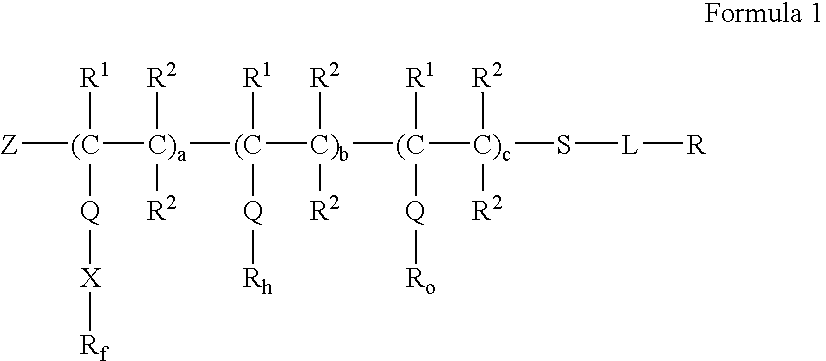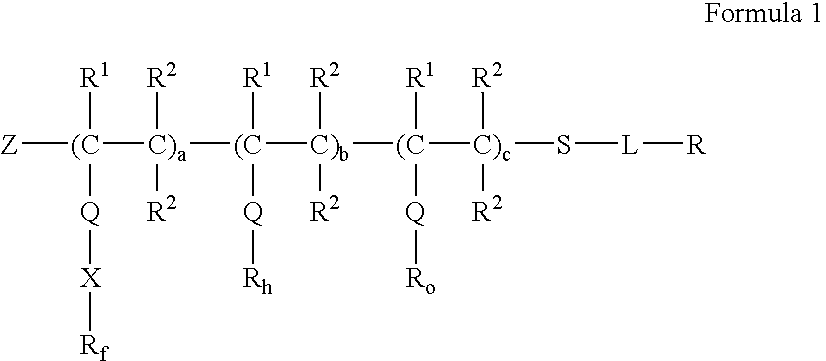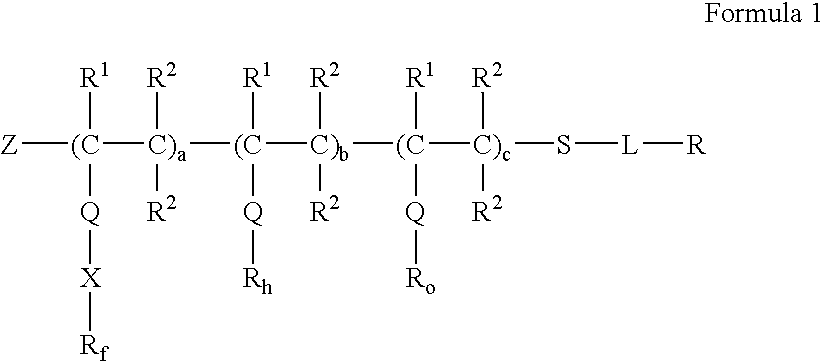Washable leather with repellency
a technology of repellency and washable leather, which is applied in the direction of transportation and packaging, synthetic resin layered products, chemistry apparatus and processes, etc., can solve the problems of not being able to achieve durable oil repellency and durable stain releas
- Summary
- Abstract
- Description
- Claims
- Application Information
AI Technical Summary
Benefits of technology
Problems solved by technology
Method used
Image
Examples
example 1
[0088] A flask was charged with 99.98 g of a solution of 62.7% by weight DESMODUR N-100 (a hexamethylene diisocyanate prepolymer available from Lanxess Corporation, Pittsburgh Pa.) in methyl isobutylketone, MIBK, (calculated 320 mmol -NCO), 1.94 g isethionic acid (13 mmol), 16.77 g stearyl alcohol (61 mmol), 16.76 g ISOFOL 18T (61 mmol, available from Sasol North America, Inc., Houston Tex.), and 57.68 g mixed 1,1,2,2-tetrahydroperfluoro-1-alkanols, predominately C8, C10, C12, and C14 with small amounts of C6, C16, and C18 (available from E. I. Du Pont de Nemours and Company, Wilmington Del., 122 mmol). With stirring, this mass was heated to 48° C. and a solution of approximately 0.027 g dibutyltindilaurate in 1-2 mL of MIBK was added to the flask. The temperature of the reaction spontaneously rose to 76° C. from the heat of reaction. The reaction mass was then further heated to 130° C. and maintained at that temperature for 21-22 hours. After the addition of 2.33 g of deionized wat...
example 2
[0089] A mixture of 2-perfluoroalkylethanols was used to prepare a mixture of tris(2-perfluoroalkylethyl) citrates. The mixture of 2-perfluoroalkylethanols was such that in their perfluoroalkyl groups, CF3CF2(CF2)k, where k was 2, 4, 6, 8, 10, 12 and 14 in the approximate weight ratio of 1 / 33 / 31 / 18 / 8 / 3 / 1, and such a mixture had an average molecular weight of about 452. The 2-perfluoroalkylethanol (4306 kg) was combined with agitation at 70° + / −5° C. with anhydrous citric acid (562 kg). Thereafter granular boric acid (2.7 kg) and aqueous phosphorous acid (6.4 kg of a 70% solution) were added as catalysts. The temperature of the reaction mixture was increased over a 3-4 h period to 130° + / −5° C. with agitation. Agitation was continued for 23-24 h while removing water formed in the reaction between the 2-perfluoroalkylethanol and citric acid. When analysis indicated that the esterification was complete, the temperature of the reaction was reduced to 70°-80° C. and butyltintrichloride (...
example 3
[0092] The tanning process was followed from the wet blue hide stage as described above and in U.S. Pat. No. 5,972,037. Wet blue hides were washed and rinsed. They were then immersed in a water float of 100% to 150% of wet blue weight and 1% by weight of the wet blue hide of sodium formate, and 0.75% by weight of the wet blue hide of sodium acetate were added as buffering agents. After buffering the hides were washed drained and refloated in water with at least 100% to 150% of wet blue hide weight. Then 6% by weight of the wet blue hide of TERGOTAN MC-N, and 4% by weight of wet blue hide of TERGOTAN EFB, each available from Clariant Corporation, Fair Lawn, N.J., were added as character builder agents to help build suppleness into the leather. After the hides were again drained washed, and refloated as previously, 4% by weight of the wet blue hides of DERMALIX C (also available from Clariant Corp.) was added as a softening agent. Dye was then added to achieve the desired color in the...
PUM
| Property | Measurement | Unit |
|---|---|---|
| temperature | aaaaa | aaaaa |
| temperature | aaaaa | aaaaa |
| angle | aaaaa | aaaaa |
Abstract
Description
Claims
Application Information
 Login to View More
Login to View More - R&D
- Intellectual Property
- Life Sciences
- Materials
- Tech Scout
- Unparalleled Data Quality
- Higher Quality Content
- 60% Fewer Hallucinations
Browse by: Latest US Patents, China's latest patents, Technical Efficacy Thesaurus, Application Domain, Technology Topic, Popular Technical Reports.
© 2025 PatSnap. All rights reserved.Legal|Privacy policy|Modern Slavery Act Transparency Statement|Sitemap|About US| Contact US: help@patsnap.com



